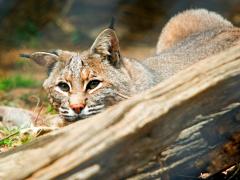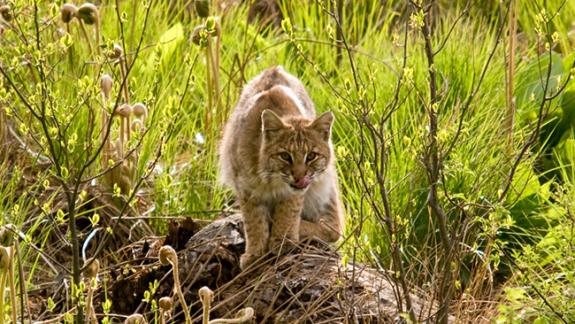New Jersey Endangered and Threatened Species Field Guide
conservewildlifenj.org
 Zoom+ A Bobcat carefully watches its prey before pouncing. © Wayne Simpson
Zoom+ A Bobcat carefully watches its prey before pouncing. © Wayne SimpsonBOBCAT
Lynx rufus
Species Group: Mammal
CONSERVATION STATUS
State: Endangered
IDENTIFICATION
The bobcat is a medium sized-cat, about two feet tall and weighting 20 pounds—larger than a housecat, but much smaller than a cougar or lion. Their fur ranges from yellowish brown to reddish brown and bears markings that vary from ‘tabby’ stripes to heavy spotting. They possess slightly tufted ears and short bobbed tails (between three and seven inches long). Generally they hunt both by night and day, although there is evidence to suggest that most hunting takes place at dawn and dusk. They are extremely shy animals that are rarely seen by humans.
 Zoom+ Range of the Bobcat in New Jersey.
Zoom+ Range of the Bobcat in New Jersey.DISTRIBUTION AND HABITAT
The bobcat is restricted to North America, and found in coniferous and mixed forest in the north, swamp areas in and around Florida, and desert and scrubland in the southwestern United States. They are absent in the highly cultivated areas of the northern mid-states, and were once widespread and common in New Jersey, probably occurring in all counties. Relentless hunting, rapid development, and massive deforestation since the turn of the century have led to its decline. Today, the bobcat is listed as one of our state’s endangered species.
DIET
Bobcats prey on rabbits, rats, squirrels, ground-nesting birds, turkeys, and even small or sick deer. They only eat about 3 pounds of meat at a time, so if they manage to catch a larger animal, they will drag it to a safe spot, cover it up, and return later to feed again. They have excellent vision and hearing, and use these senses most in hunting. The soft pads on their feet help them sneak up quietly on their prey.
LIFE CYCLE
Bobcats like to den in crevices in rocks, under fallen logs, or under the root mass of a fallen tree. They generally breed between February and June, and have a litter size of 1-6 young which are born after a gestation period of approximately 60 days. The spotted kittens are weaned at about 12 weeks. As the kittens are weaned, they begin eating meat that the mother brings back for them. Later, she will bring live animals (like mice) back to the den, so the kittens can practice hunting. A bobcat becomes independent of its mother at about 10-12 months of age, and lives 12-13 years in the wild.
CURRENT THREATS, STATUS, AND CONSERVATION
In New Jersey, European settlement brought hard times for bobcats; they were hunted relentlessly, as were all of our large predators. The greatest blow to the once large population was the massive deforestation that occurred here at the turn of the century. As forests were cleared for lumber, fuel and charcoal, and land was converted to agricultural use, bobcat habitatbecame fragmented. Populations became isolated and plummeted. Scattered reports of bobcats being seen or killed on roads continued throughout the 1950s and 1960s, and the species was listed as a state endangered species in June of 1991.
The state began a project where 24 bobcats captured in New England were released in northern New Jersey from 1978-1982. Regular reports of sightings of bobcats have been made since these releases. In addition, a road killed specimen was recovered in 1982 that was not one of the released cats and too old to be offspring of the releases. This confirmed that at least a remnant population of bobcats still existed at the time of the releases.
 The elusive bobcat is spotted in its native habitat. © George Cevera
The elusive bobcat is spotted in its native habitat. © George Cevera
Since 1991, our management efforts have led to consistent bobcat sightings from an increasingly larger area of northern New Jersey. Most sightings continue to come from Warren, Sussex, Passaic and Morris counties but there have been recent sightings from Bergen, Hunterdon, Ocean, Cape May, Cumberland and Salem counties. Although too early to tell whether the increase in sightings is due to more people encroaching into areas where bobcats live, it is possible that the increase in sightings may be an indication that the once nearly extinctpopulation is growing.
In February of 1997, biologists captured three adult male bobcats to fit them with radio collars. This would allow them to track the bobcats and find out where they lived and hunted. The information from this study provided important data necessary to protect the habitat needed for bobcats to survive in New Jersey. The captured cats were anesthetized, weighed, measured and fitted with a standard radio collar that had a 24-month battery life. The cats were tracked for ten months after their release.
This project continued in the winters of 1997-1998 and 1998-1999 with unsuccessful attempts to capture additional bobcats. A fourth bobcat was captured in Sussex County in February 2000. While tracking the new bobcat, a radio collar of the remaining original cats captured in February 1997 was found to be still transmitting a signal. The exceptionally long battery life of this collar has allowed us to confirm that this cat is alive and well and using the same home range as during the original monitoring period.
The project was expanded to use satellite radio collars to track cats after they are captured. In January of 2002, a bobcat was captured and fitted with this new collar. This new technology has made it easier to find the secretive cats and has provided more accurate information about their location.
In 2005, a new project began to train a working dog to search for bobcat scat. DNA can be extracted from the scat, which can tell us the gender of the bobcat and distinguish between individuals. In the winter of 2006-2007, using the working dog, Bear, scat was found from 21 different bobcats, 12 females and 9 males. This project will continue in the winter of 2007-2008.
Additionally, in the winter of 2007, a training was held to train volunteers to identify and document bobcat tracks. Volunteers documented bobcat tracks from 3 different locations after the workshop. This project, as well as the bobcat scat research, continues. Volunteers are always be recruited to expand the search area for New Jersey’s bobcats.










No comments:
Post a Comment